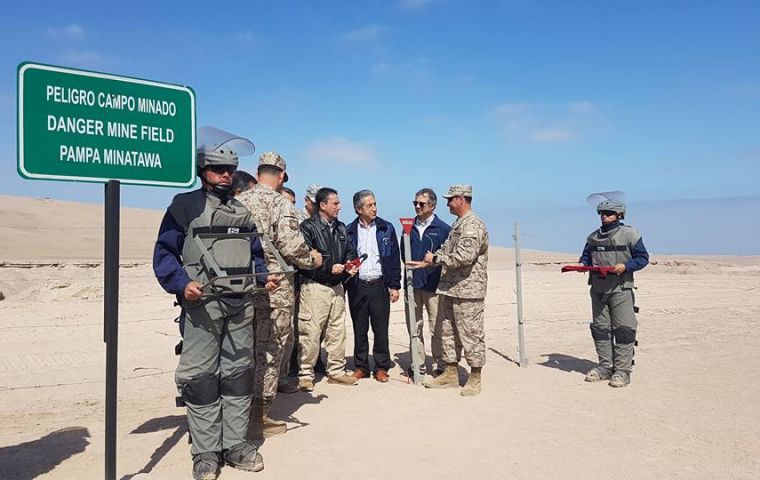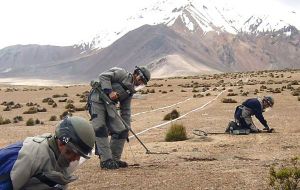MercoPress. South Atlantic News Agency
Chile has cleared 140 of 194 minefields; by 2020 the territory should entirely free
 “The number of minefields in Chile was 194, it's down to 140, which means 54 are pending, in the regions of Antofagasta and Magallanes”, revealed Colonel Ventura.
“The number of minefields in Chile was 194, it's down to 140, which means 54 are pending, in the regions of Antofagasta and Magallanes”, revealed Colonel Ventura.  ”We have completed the destruction of 31.000 mines, which makes a total of 84.523, of the 113.122, that were 'planted' in the (north) region of Arica and Parinacota”
”We have completed the destruction of 31.000 mines, which makes a total of 84.523, of the 113.122, that were 'planted' in the (north) region of Arica and Parinacota” Chile has cleared 72% of minefields in its territory, and expects to have finished the task by March 2020, according to the head of the country's De-mining Committee Army Colonel Rodrigo Ventura.
“The number of minefields in Chile was 194, and we have brought that down to 140, which means 54 are pending, in the extreme regions of Antofagasta and Magallanes”, revealed Colonel Ventura.
De-mining operations are the responsibility of specially trained groups of the Chilean Army, which is a task of “high risk” and the teams include several women.
The data was revealed during a ceremony in which a total of 1.7 million square meters of mine-cleared area were officially delivered to the Chilean National Assets ministry in the north of the country close to the border with Bolivia and Peru.
“We have freed 13 fields which are now in the hands of small farmers. It's an important farm area, and it is part of Chile's international commitment with the Ottawa Treaty, and we are announcing that our efforts are geared to the goal of having the Chilean territory cleared of all mines, anti tanks and anti personnel, by autumn 2020”, indicated the Chilean Army authorities.
With this last delivery of land ”we have completed the destruction of 31.000 mines, which makes a total of 84.523, of the 113.122, that were 'planted' in the (northern) region of Arica and Parinacota.
In an interesting revelation, Bernardo Veksler, an Argentine historian of Patagonia and Tierra del Fuego who regularly writes in the Ushuaia daily Diario Fin del Mundo, pointed out that Chilean military started to plant mines in the disputed Beagle channel islands, extreme south of the continent, in May 1983. Until now it was always believed that the massive mining task by Chileans along neighboring borders was in 1978, fearing a conflict with Argentina, Bolivia and Peru.
However Veksler says that in 1983, the Chilean military feared that the retreating Argentine dictatorship after the Falklands' defeat, daily protests in the country and political parties reorganizing, could attempt some desperate move or gesture.
At the time the Picton, Lennox and Nueva islands along the Beagle channel were still under demarcation dispute between Chile and Argentina, and an attempt to recover them and plant the Argentine flag could be a desperate move to save the Argentine military honor. Besides the Argentine military were furious with their neighboring peers for extending logistics support to the British during the Falklands' conflict.
And in effect, years later a journalist investigation of the Picton island, where an only family was living, showed there were several minefields, six in total, along cliffs, with 1.307 antipersonnel explosives. In the Nueva island, seven minefields were registered with 1.286 explosives. The areas are clearly signaled and have warning fence perimeters.
As it is known the Argentine dictatorship faded ignominiously, and by December 1983, a freely elected government had taken office in Buenos Aires. However according to Veksler, the mining effort started by Chile four years ago, still has to address the three Beagle islands, plus the islands of Deceit, Freycinet and Hornos, where the oceans change names.




Top Comments
Disclaimer & comment rules-

-

-

Read all comments1. Chile had previously represented to the international community that they would remove all mines by the year 2010. Ooops.
May 29th, 2016 - 03:58 pm 02. The Chilean government website which purported to identify for the benefit of the public the locations of all the minefields, in fact failed to show on their website all those minefields, including those that were clearly marked at their physical sites.
3. The need to place the mines in the first place was in response to the aggression by neighbouring Argentina, and the assumption that Bolivia and Perú would enter the fray following Argentina's planned invasion in 1978.
4. It is fashionable in Argentina today to deny that Argentina was planning to invade Chile to seize Chilean territory in the Beagle Channel area, just as it is fashionable here (in Argentina) to deny the genocides against the indigenous peoples, to deny default events, to deny inflation rates, to deny crime rates, to deny corruption levels, and so on . The perpetual state of denial.
Marti
May 29th, 2016 - 08:59 pm 0You're correct for the reason why we planted mines on or borders. Especially in 1978.
Probably why it has taken so long to remove them is because some maps were poorly made and sometimes mines shift location in the sands.
Other than killing an occasional drug smuggler or Guanaco, mines are not that all of a problem anyway...
@2 In Magallanes there was a lot of pressure from the tourism industry and the overly squishy that the minefield signs and the presence of minefields was bad public relations, that it somehow harmed tourism, that the “imagen país” was thus damaged. So the intendente worked to prioritise the removal of the mines and signs between Natales and Torres del Paine. Of course there are still very visible minefields between Punta Arenas and Natales so I am not sure just what was accomplished. In that same section, near Cabeza del Mar, there is evidence that the Chilean forces in 1978 did a good job of preparing defensive positions to channelise the anticipated argie invasion and make them pay dearly for every meter of ground. Near those minefields there also large-diametre concrete pipe sections that were dug in for protecting the Chileno defenders against overhead artillery ordnance bursts. The people in this region who were here in 1978 remember very well the imminent threat of the argie invasion, something they have in common with the islanders. Though tensions are lower these days, Chile still keeps one of its best tank regiments next door to Puerto Natales. They are more than a match for any armoured unit in Argentistan these days.
May 29th, 2016 - 10:59 pm 0In the north the minefields are useful for controlling incursions by the cholivians and the peruchos (not to be confused with peronchos) - as you indicated. But there have been cases of the mines getting washed into arroyos during storms, and then (since they float) appearing on the beaches near Arica.
Mine clearing is a nasty business. Until very recently I kept my old plastic mine-probe from the 1991 war (Gulf War/Operation Granby/Desert Storm).
saludos
Commenting for this story is now closed.
If you have a Facebook account, become a fan and comment on our Facebook Page!